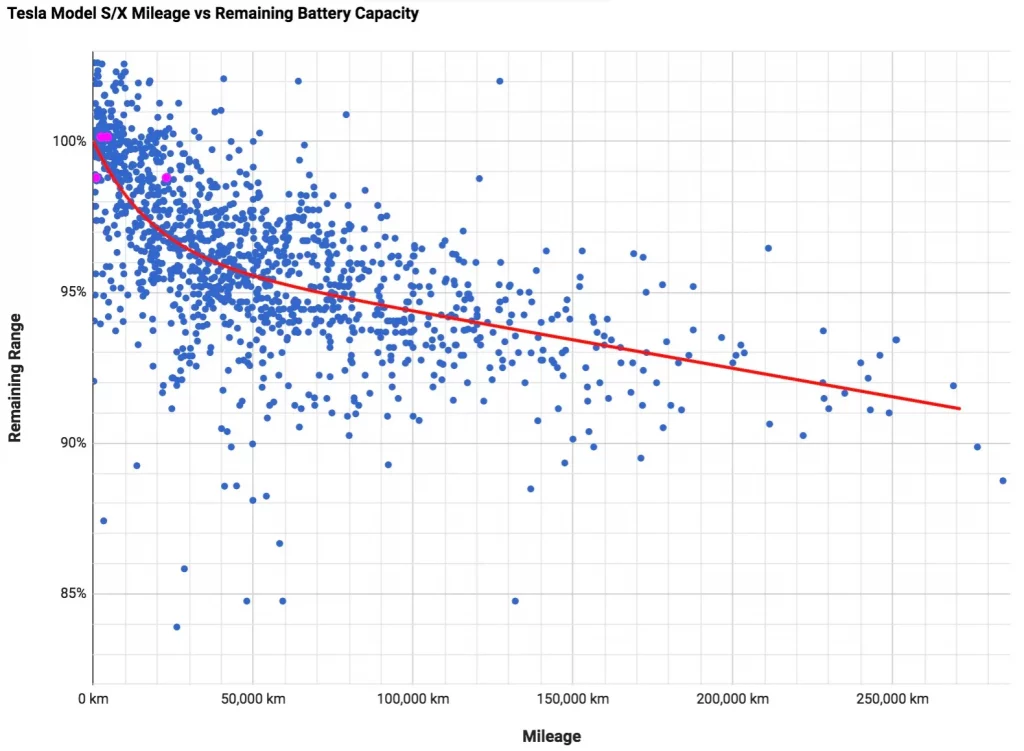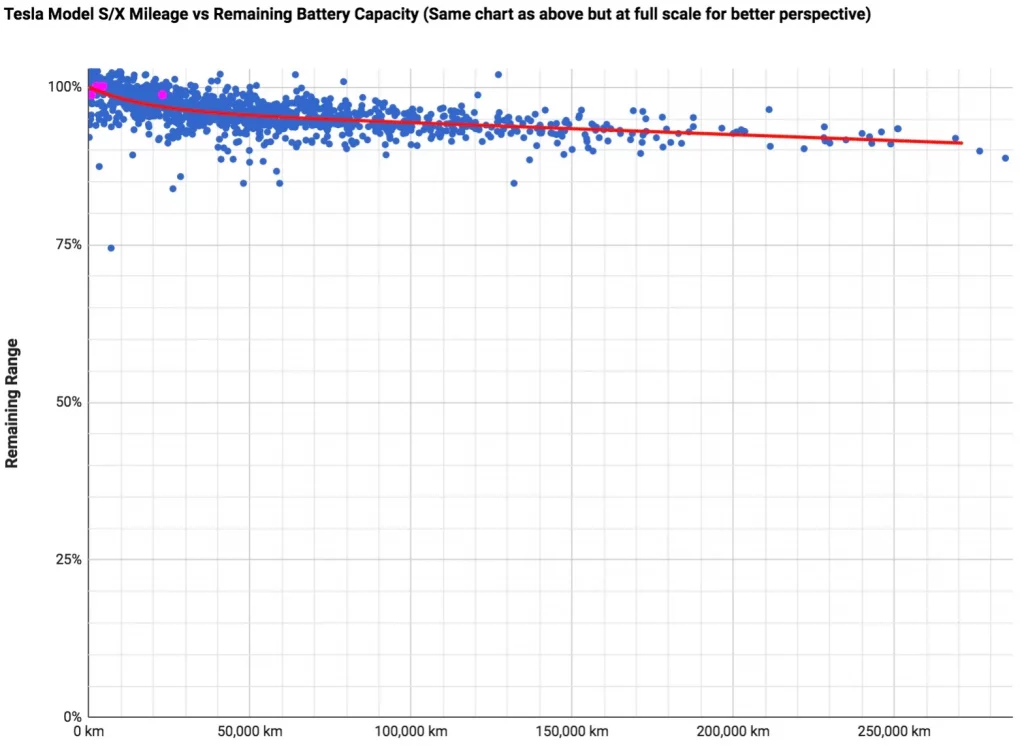Electric vehicles have been around for decades, but the industry only really picked up after new battery technologies (that provided greater autonomy) were developed.
Tesla was one of the pioneers of this new EV approach, designing electric cars with great range and outstanding performance in mind.
But despite the emergence of new battery technologies, one thing was/will always be inevitable: batteries degrade over time, and their lifespan is still shorter than most car parts. For this reason, battery replacements are commonplace, even for Tesla vehicles.
Still, one question remains: How long do Tesla batteries last?
In this article, we’ll discuss Tesla EV battery life. We’ll cover the different Tesla batteries, how long they last, their degradation process, and the range they provide.
Table of Contents
Are All Tesla Batteries The Same?
No, not all Tesla batteries are the same; they’ve evolved over the years in terms of their battery cell and pack structure to provide higher capacity and, therefore, more range. However, despite a few differences, they’re all lithium-ion batteries.
Tesla batteries differ according to the vehicle’s model and year. But what makes them different? Well, mainly their capacity (60 kWh, 75 kWh, 85 kWh, 90 kWh, 100 kWh, etc.).
Over the years, Tesla developed different batteries to increase capacity, power, and range.
The company has made significant improvements in five key areas of its batteries:
- Cell design (specifically form factor);
- Battery cell factory design with manufacturing innovations;
- New anode materials;
- New cathode materials;
- New battery pack design.
Battery Cell Types Used By Tesla:
- 1865-type: Roadster (original), Model S, Model X
- 2170-type: Model 3, Model Y
- 4680-type: Model Y Made in Texas (in the future, also Model Y from Germany and new models)
- Prismatic: entry-level Model 3 and Model Y and cathode (NCA, NMC, and LFP)

Source: “Design Considerations of High voltage Battery Packs for Buses.”
In addition, Tesla uses different lithium-ion chemistries, which evolved over the years:
- Lithium Iron Phosphate (LFP)
- Nickel Cobalt Manganese (NMC)
- Nickel Cobalt Aluminum (NMA)
In September of 2020, Tesla held an event (streamed on Youtube) called “Tesla Battery Day,” in which they presented their latest battery technology developments.
Here’s the video:
How Long Does A Tesla Battery Last?
The answer to this question is not so simple; Tesla battery life can vary from one vehicle to another.
Apart from natural degradation, a few factors can impact battery life, including:
- Driving habits
- Charging practices
- Environmental Factors
- Software updates
Additionally, given that Tesla is a relatively new company, there still isn’t enough data related to battery life to provide you with a more accurate answer.
For instance, Tesla released its first car in 2008 — 13 years. It isn’t a lot of time to accurately evaluate battery lifespan and performance, especially considering that it varies from user to user.
However, we can estimate Tesla battery life thanks to the company’s extensive research and the data that Tesla owners shared about their batteries.
Let’s have a closer look at the numbers.
Tesla Battery Life: Numbers
According to Elon Musk, a Model 3’s (current) battery modules should last between 300 thousand miles (~483 thousand km) and 500 thousand miles (~805 thousand km).
Let’s consider the average miles driven per year in the U.S. — 14.263 miles (22.953 km) according to the U.S. Department of Transportation’s Federal Highway Administration. Now we can convert the battery life from miles to years.
Let’s divide the estimated Tesla battery life, as stated by Elon Musk, by the average miles driven per year:
Battery life (years) = 300.000 miles / 14.263 miles = 21 years
Battery life (years) = 500.000 miles / 14.263 miles = 35 years
The Result
A Tesla battery can last between 21 to 35 years (in ideal conditions).
Honestly speaking, 35 years is a bit of a stretch, but 20 or so years doesn’t seem so out of reach.
Of course, these numbers are estimated in ideal conditions and consider proper usage, correct charging habits, and good maintenance practices.
In reality, other factors impact battery life. Still, you can expect your Tesla battery to last between 300 thousand to 450 thousand miles before its capacity degrades considerably (more than 30% of its original capacity).
Tesla Battery Degradation Chart
Tesla owners are usually worried about battery degradation over their vehicle’s lifespan.
Thankfully, Tesla batteries generally offer a long service life.
They have a sophisticated battery management system (BMS), which controls charging, discharging, and battery temperature, maximizing efficiency and longevity to slow down the degradation process.
For this reason, Tesla has historically been able to limit degradation to reasonable levels.
Still, battery degradation is inevitable, so let’s look at the data on Tesla battery degradation to understand how Tesla batteries degrade over time.

Source: electrek.co
Notice that, after 200.000 km (~125 miles), Tesla batteries degrade about 7,5% of their total capacity (the remaining range is around 92,5%).

Source: electrek.co
Looking at the chart at full scale, we can see that battery degradation occurs relatively slowly, maintaining 90% of the total range after over 270,000 km (168,000 miles).
Additional Data Regarding Tesla Battery Degradation
Data collected from several Tesla users has shown that after about 500 to 800 charging cycles (around 160,000 miles), the battery’s capacity drops to approximately 70% of its original capacity for 100% depth of discharge.
However, most Tesla owners don’t usually drain their batteries from 100% to 0%. This way, Tesla batteries can easily perform over 800 cycles before suffering considerable capacity loss (around 30% of total capacity).
Tesla offers a battery warranty covering battery capacity degradation for all its vehicles, with a minimum 70% retention of battery capacity over the warranty period (8 years or 100,000 to 150,000 miles, depending on the Model).
How Much Range Do Tesla Batteries Get?
Each model has a different battery pack, giving them their respective range.
You can find the estimated ranges for each model on Tesla’s website. However, we organized the info in the table below (for your convenience).
| Model and Version | Total Range (EPA est.) | Usable Range (20% to 90% SoC) |
|---|---|---|
| Model S | 405 mi / 652 km | 284 mi / 456 km |
| Model S Plaid | 396 mi / 637 km | 277 mi / 446 km |
| Model 3 Performance | 315 mi / 507 km | 221 mi / 355 km |
| Model 3 Long Range AWD | 358 mi / 576 km | 251 mi / 403 km |
| Model 3 Standard Range Plus | 272 mi / 438 km | 190 mi / 306 km |
| Model X | 348 mi / 560 km | 244 mi / 392 km |
| Model X Plaid | 333 mi / 536 km | 233 mi / 375 km |
| Model Y Performance | 303 mi / 488 km | 212 mi / 341 km |
| Model Y Long Range | 330 mi / 531 km | 231 mi / 372 km |
The usable range considers only 70% of the total range capacity since Tesla advises not to drain the battery below 20% state of charge and to not go charge over 90% (unless you’re preparing for a long trip).
Estimating Battery Life In Cycles
Let’s estimate the number of cycles each Tesla model can perform.
For estimation purposes, let’s consider 300 thousand miles of battery life as the best-case scenario.
If we consider the usable range for each model, we can estimate how many cycles (from 90% SoC to 20% SoC, or 70% DoD) a Tesla battery can perform (for each Model).
For example, let’s take the usable range of the Model 3 Long-Range, which is 251 miles (403 km). Therefore:
Battery life (cycles) = 300.000 miles / 251 miles = 1195 cycles
We carried out the same calculation for each model and organized the results in the table below:
| Model and Version | Battery Life in Cycles |
|---|---|
| Model S | 1056 cycles |
| Model S Plaid | 1083 cycles |
| Model 3 Performance | 1357 cycles |
| Model 3 Long Range AWD | 1195 cycles |
| Model 3 Standard Range Plus | 1578 cycles |
| Model X | 1229 cycles |
| Model X Plaid | 1287 cycles |
| Model Y Performance | 1415 cycles |
| Model Y Long Range | 1298 cycles |
How Can You Make A Tesla Battery Last longer?
The best way to make your Tesla battery last longer is to follow the manufacturer’s recommendations.
We checked Tesla’s website; here’s what the company recommends to keep your Tesla battery healthy and avoid premature degradation:
Tesla’s Recommendations For Prolonging Battery Life
- Always charge your Tesla with the correct charger; only a proper charger can “communicate” with your vehicle’s system and thus provide appropriate charging specifications. (Click here for more info)
- Tesla offers a ‘wall connector’ charger, which is excellent for home charging since it provides the correct charging specs. The mobile charger supplied by the company is also a good option, but it charges at a slower rate.
- Tesla recommends plugging in your Tesla every night to top off your battery. However, you should adjust your charging settings to stop charging once it reaches 90% SoC.
- For regular use, Tesla recommends keeping the vehicle within the ‘daily’ range bracket: above 20% and below 90% state of charge.
- Since Tesla uses lithium-ion batteries, there is no need to deplete the battery before charging because this type of battery does not suffer the memory effect.
- You can plug in your Tesla as often as possible.
- Maintain a regular, everyday charging routine using a low-voltage charger (i.e., Wall Connector at your home).
- Avoid allowing the battery to get too low in charge.
- Only use DC Fast Charging (i.e., Supercharging) when necessary. Save it for long road trips.
- Avoid charging your Tesla at extreme temperatures.
- Precondition your battery before supercharging it (if your Tesla isn’t set to precondition the battery automatically).
Summary
Following Tesla’s recommendations increases battery life significantly. In general, Tesla owners who follow the battery maintenance recommendations only start to notice battery degradation (capacity loss) after 1,200 to 1,500 charging cycles or around 300,000 miles of life.
So if you ride about 15 thousand miles (~24 thousand km) a year (which is 41 miles/66 km a day), you’re probably looking at 20 years of battery life on your Tesla.
Also, if your Tesla battery starts to degrade considerably, don’t panic; you can replace a Tesla battery. Tesla offers 8 years of warranty for battery modules.
Final Thoughts
The battery is probably the most critical part of an electric car, so it’s crucial that it lasts a relatively long time without compromising its performance.
Most buyers are interested in knowing how long a Tesla battery lasts before investing in such a vehicle. And they’re often happy to discover that Tesla batteries are designed to last a long time if properly maintained.
According to Elon Musk, Tesla battery modules can last from 300,000 miles to 500,000 miles; this translates to 20 to 25 years.
Before buying an electric vehicle, it’s essential to research which EV best suits your needs in terms of total range capacity (per charge), battery life, performance, power, etc.
If you want to share your thoughts or ask us a question, please feel free to reach out to us in the comments section below! Alternatively, visit our forum or follow us on Twitter!

